Enhancing Focus in Children with Autism Using Evidence-Based Strategies
Introduction to Token Economies in ABA
Token economies are a foundational reinforcement strategy extensively utilized in applied behavior analysis (ABA) to shape and maintain desirable behaviors. This structured approach involves using tangible tokens as conditioned reinforcers, which can later be exchanged for meaningful backup reinforcers. By systematically reinforcing specific target behaviors, token economies foster motivation, consistency, and progress across various settings such as schools, clinics, and homes. Understanding how these systems operate, their components, and their underlying principles can significantly enhance behavioral outcomes.
What is a Token Economy in Behavioral Therapy and How Does It Work?
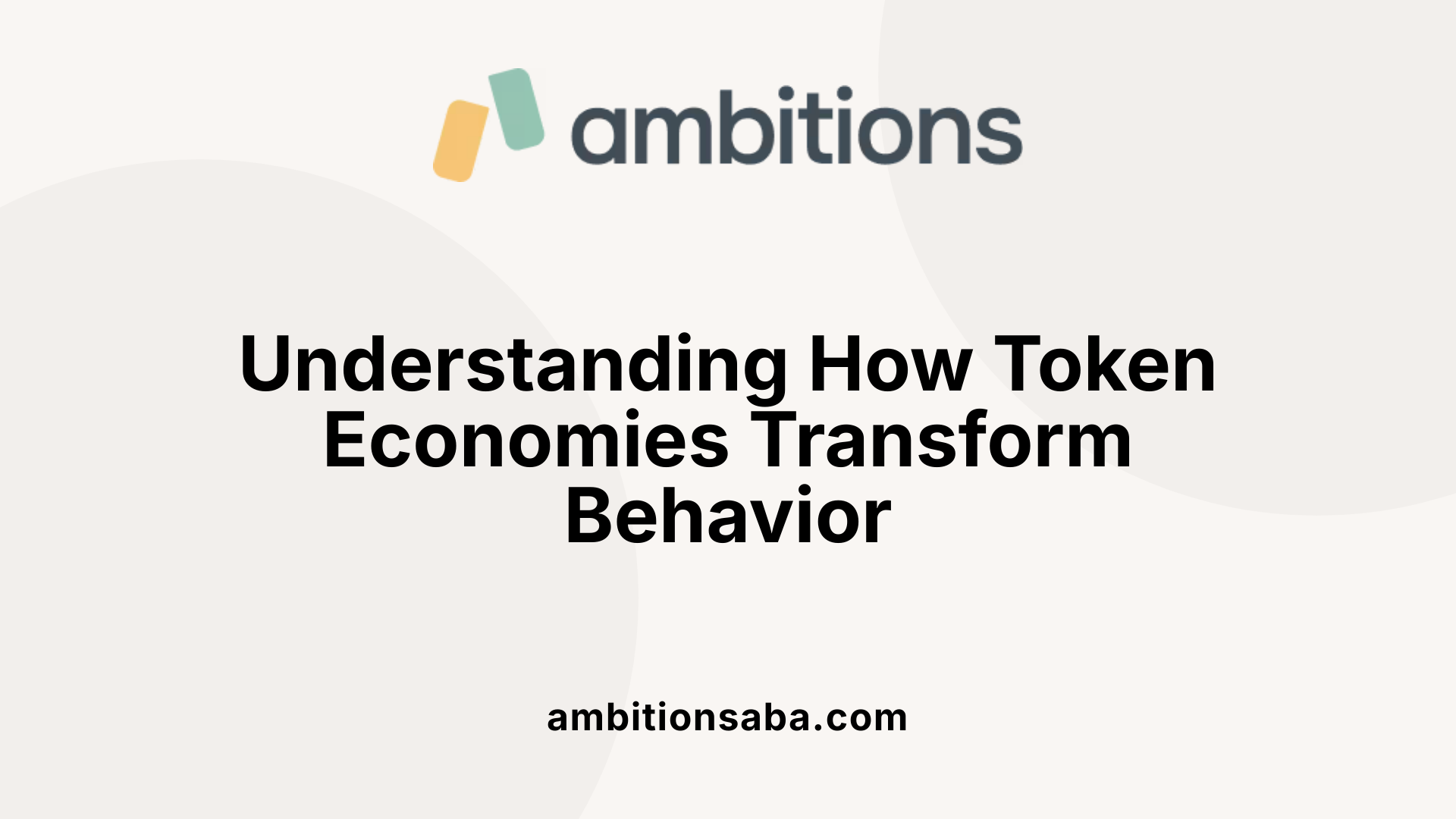
What is a token economy in behavioral therapy and how does it work?
A token economy is a structured reinforcement approach that uses tangible tokens as conditioned reinforcers to encourage positive behaviors. It is widely used in behavioral therapy settings like schools, homes, and clinics.
The process involves awarding tokens—such as stickers, poker chips, or points—for specific target behaviors like completing homework, participating in activities, or showing social skills. These tokens are conditioned reinforcers, meaning they gain value through repeated pairing with backup reinforcers like favorite treats or privileges.
Individuals can accumulate tokens and later exchange them for these backup rewards. This system creates a clear and predictable link between behavior and reinforcement, making it easier to motivate desired actions.
How do tokens serve as conditioned reinforcers?
Tokens act as secondary or conditioned reinforcers because they are not inherently rewarding on their own. Instead, they acquire value through consistent pairing with backup reinforcers, which are typically preferred items or activities.
For example, a child might earn a star sticker (token) for cleaning up toys. After collecting enough stickers, they can exchange them for extra playtime or a favorite snack. This pairing process strengthens the link between the tokens and the backup reinforcers, encouraging repeated desirable behaviors.
What is the process of earning and exchanging tokens?
First, practitioners identify specific target behaviors to reinforce. Then, they select appropriate tokens that are appealing and easy to use. Once the system is set up, individuals earn tokens immediately after engaging in the target behaviors.
Tokens are accumulated and can be exchanged during scheduled times for backup reinforcers, which are meaningful rewards. The reinforcement schedule can start with continuous reinforcement—every behavior earns a token—and gradually thin out as behaviors become more established.
How are tokens used in different environments?
Token economies are effective across various settings including schools, homes, summer camps, and inpatient facilities. Their versatility allows customization to individual needs and preferences.
In classrooms, teachers may use token charts to motivate students. In homes, parents can reinforce chores and social skills. ABA therapists use token systems to teach communication, self-care, or social behaviors. Regardless of the environment, the goal remains consistent: to promote positive behavior through a visible, structured reinforcement system.
| Environment | Typical Use Cases | Benefits |
|---|---|---|
| School | Classroom behavior, task completion | Increased engagement and task fulfillment |
| Home | Chores, social skills improvement | Promotes independence and routine |
| Camps/Programs | Group activities, prosocial behaviors | Encourages participation and cooperation |
| Therapy Settings | Skill acquisition, reduce maladaptive behaviors | Consistent reinforcement, measurable progress |
Benefits of Using Token Economies in ABA Sessions
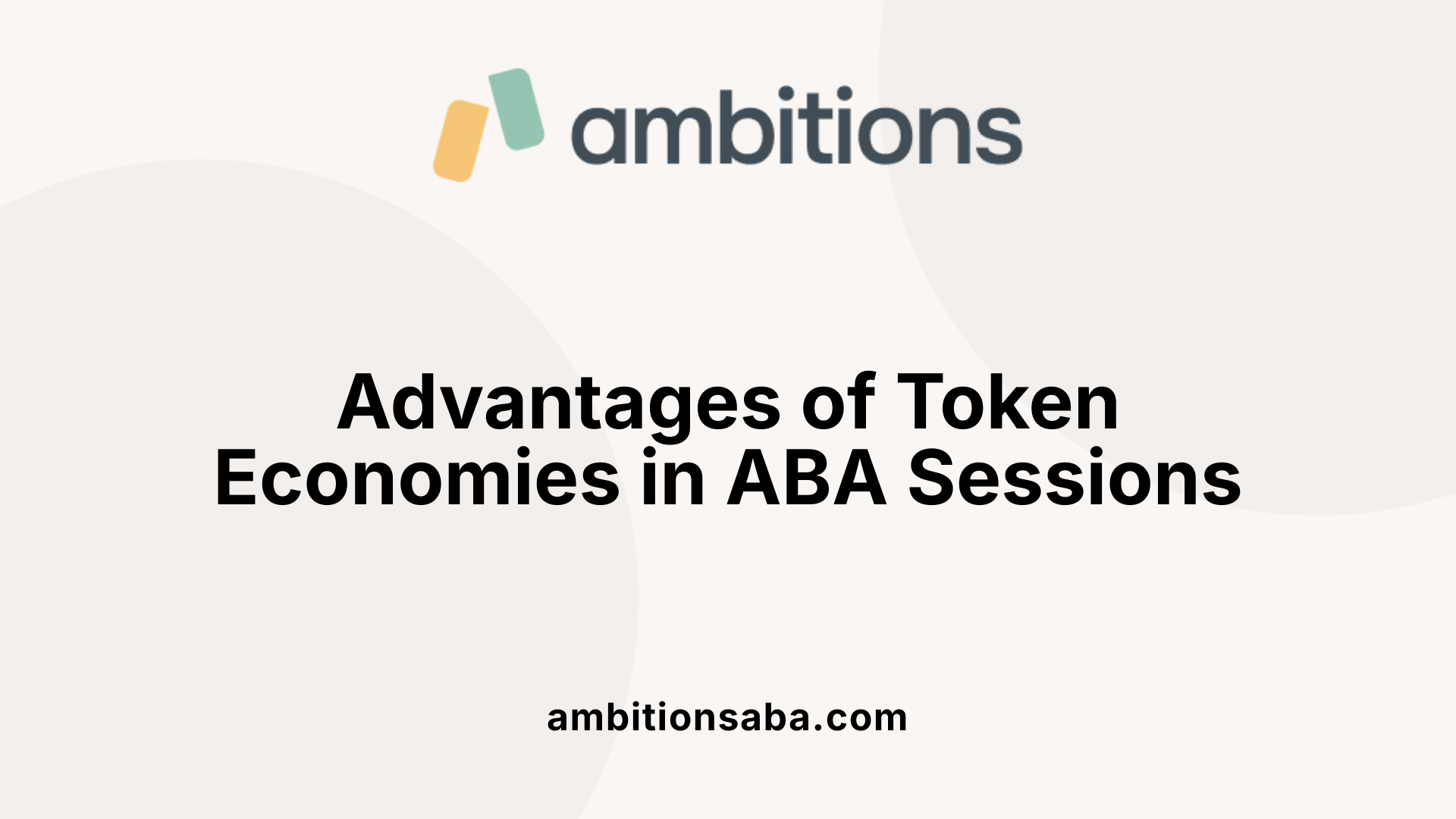
What are the benefits of using token economies in ABA sessions?
Token economies are a widely used strategy in applied behavior analysis (ABA) for reinforcing desirable behaviors. One of their primary advantages is the ability to provide immediate reinforcement. When learners earn tokens right after exhibiting target behaviors, it creates a clear link between the behavior and the reward. This immediacy boosts motivation, making learners more likely to repeat positive actions.
The visual aspect of tokens also plays an important role. Tokens, such as stickers or chips, serve as tangible and visual proof of progress. This visual feedback helps learners see their achievements, which can increase their engagement and encourage continued effort.
Furthermore, token economies support the development of complex skills. Because tokens are exchanged for backup reinforcers—anything the learner finds meaningful—they can be used to reinforce a wide range of behaviors, from academic tasks to social skills.
In addition to motivating learners, token systems assist with behavior management. They allow structured reinforcement schedules and response costs, helping to decrease unwanted behaviors by establishing clear consequences.
Overall, implementing a token economy fosters a positive, predictable environment where learners are encouraged to develop new skills and maintain behaviors over time. The strategy's flexibility makes it suitable for various settings including schools, homes, and clinical environments.
Research consistently supports the use of token economies as an effective element of ABA, with proven benefits in increasing task completion, promoting skill acquisition, and supporting behavior modification.
Implementing a Token Economy System in ABA
How do you implement a token economy system in ABA?
Implementing a token economy in ABA starts with a clear plan that incorporates several crucial steps. First, it is essential to identify specific, measurable target behaviors that you aim to increase or reduce. These behaviors could include completing assignments, participating in group activities, or practicing social skills.
Once target behaviors are defined, select tokens that will serve as conditioned reinforcers. Common tokens include stickers, poker chips, or points that are appealing and learned to have value through pairing with primary reinforcers.
Next, develop a backup reinforcer menu—a variety of desirable items or privileges that the individual values and can be exchanged for tokens. This could include extra playtime, small toys, or preferred activities.
Create a structured system, often visual such as a token board, where tokens are awarded immediately after the desired behavior occurs. Consistency in delivering tokens is vital to establish their conditioned reinforcing value.
Set clear rules for how many tokens are required to access different backup reinforcers. This involves establishing schedules for reinforcement and exchanges, which can be gradually thinned over time.
Monitoring and data collection are ongoing processes throughout implementation. Regularly reviewing progress allows for adjustments to be made, ensuring ongoing effectiveness and motivation.
Finally, as behaviors improve and routines become established, it's important to systematically fade the use of tokens and transition to other reinforcement strategies like behavior contracts. This promotes independence and maintains desirable behaviors over the long term.
Components of a Token Economy System
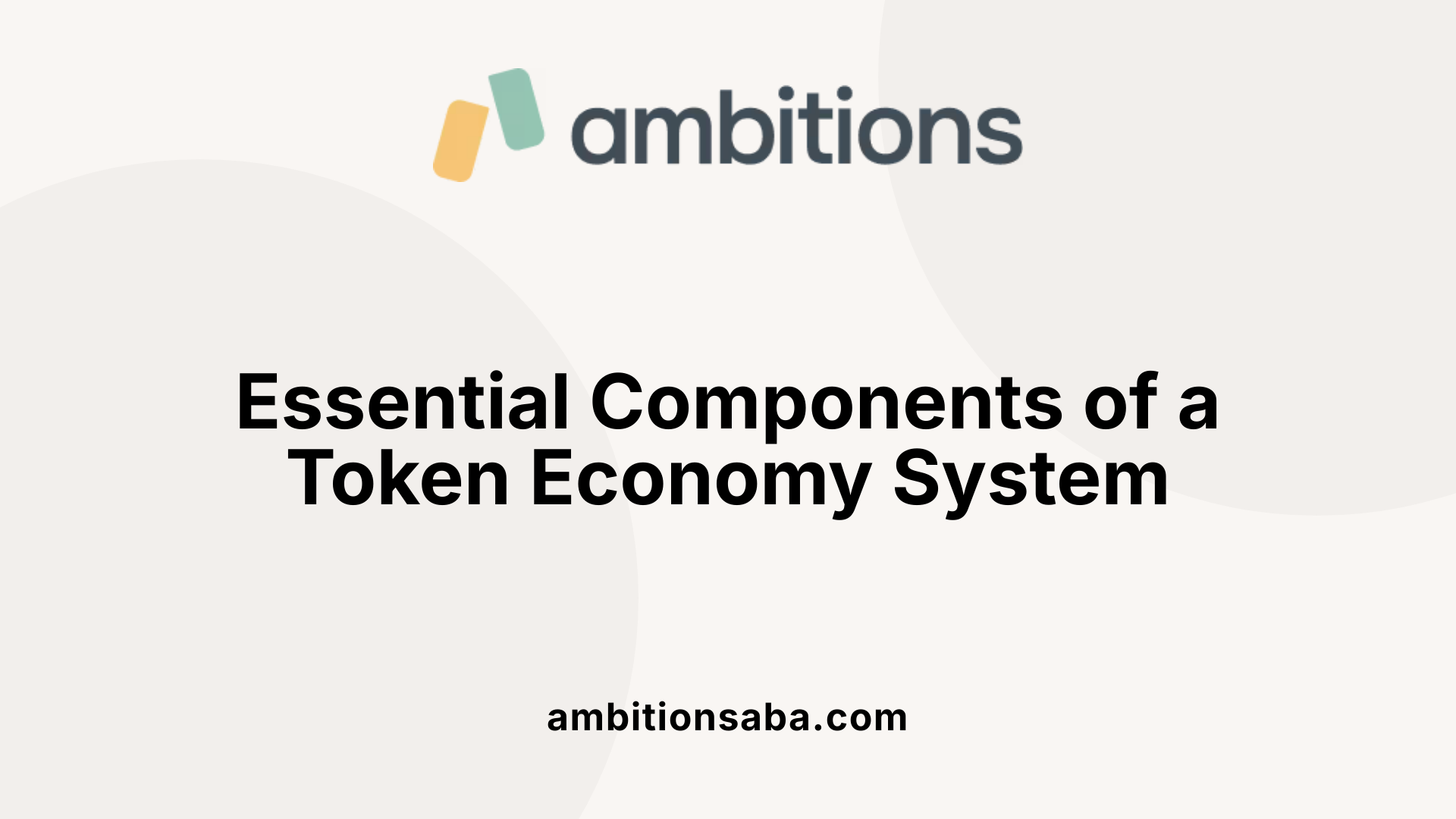
What components are involved in a token economy system?
A well-structured token economy in Applied Behavior Analysis (ABA) includes several essential parts. First, tokens are the conditioned reinforcers that individuals earn for engaging in target behaviors. These can be tangible objects like stickers or poker chips, or visual marks on charts. They have no inherent value but gain significance through pairing with backup reinforcers.
Next, backup reinforcers are the actual rewards or privileges that individuals desire and exchange their tokens for. These could be preferred activities, toys, or other engaging objects and experiences tailored to the learner’s preferences.
Token boards or charts provide visual representation of progress, showing how many tokens have been earned and how many are needed to exchange for reinforcers. This visual feedback supports motivation and helps learners understand their achievements.
The system also requires clear rules about how tokens are earned and exchanged. These include the specific target behaviors, the number of tokens needed for each backup reinforcer, and the timing of exchanges.
To successfully implement a token economy, careful planning of procedures and consistent application are necessary. These components synergize to reinforce desirable behaviors, promote learning, and increase motivation in various settings such as schools, home, or therapy environments.
Principles Underlying the Use of Token Economies in ABA
What principles underlie the use of token economies in ABA?
Token economies are based on core principles of applied behavior analysis (ABA). They use positive reinforcement to encourage desirable behaviors by awarding tokens—small objects like stickers, chips, or points—each time a person demonstrates a target behavior.
These tokens serve as conditioned reinforcers, meaning they gain their value through pairing with backup reinforcers, such as favorite activities, treats, or privileges. When individuals earn tokens for specific behaviors, they learn to associate these tokens with larger, meaningful rewards.
A vital aspect of token economies is their ability to provide visual feedback. Staff, teachers, or caregivers can track progress with charts or token boards, helping individuals see their achievements and stay motivated. This visual system supports ongoing engagement and clear expectations.
Another important principle is accepting delayed gratification. Tokens allow a person to earn reinforcers not immediately after each behavior but after accumulating a certain number of tokens. This process helps teach patience and self-control, facilitating better behavior management over time.
Fading is a critical strategy used to transfer control from tokens to intrinsic motivation or less structured reinforcement. As behaviors become more consistent, the frequency of token delivery is gradually reduced. This process encourages generalization, meaning the skill is maintained across different settings and situations, even without the continuous need for tokens.
Implementing a successful token economy involves carefully selecting the target behaviors, choosing motivating tokens, and establishing consistent reinforcement schedules. Regular assessment and data collection are key to monitor progress, adjust reinforcers, and ensure the system remains effective.
Overall, the systematic use of tokens rooted in ABA principles promotes not only the acquisition of new skills but also the maintenance of positive behaviors, guiding individuals toward greater independence and adaptive functioning.
When Is a Token Economy Appropriate in Behavioral Intervention?
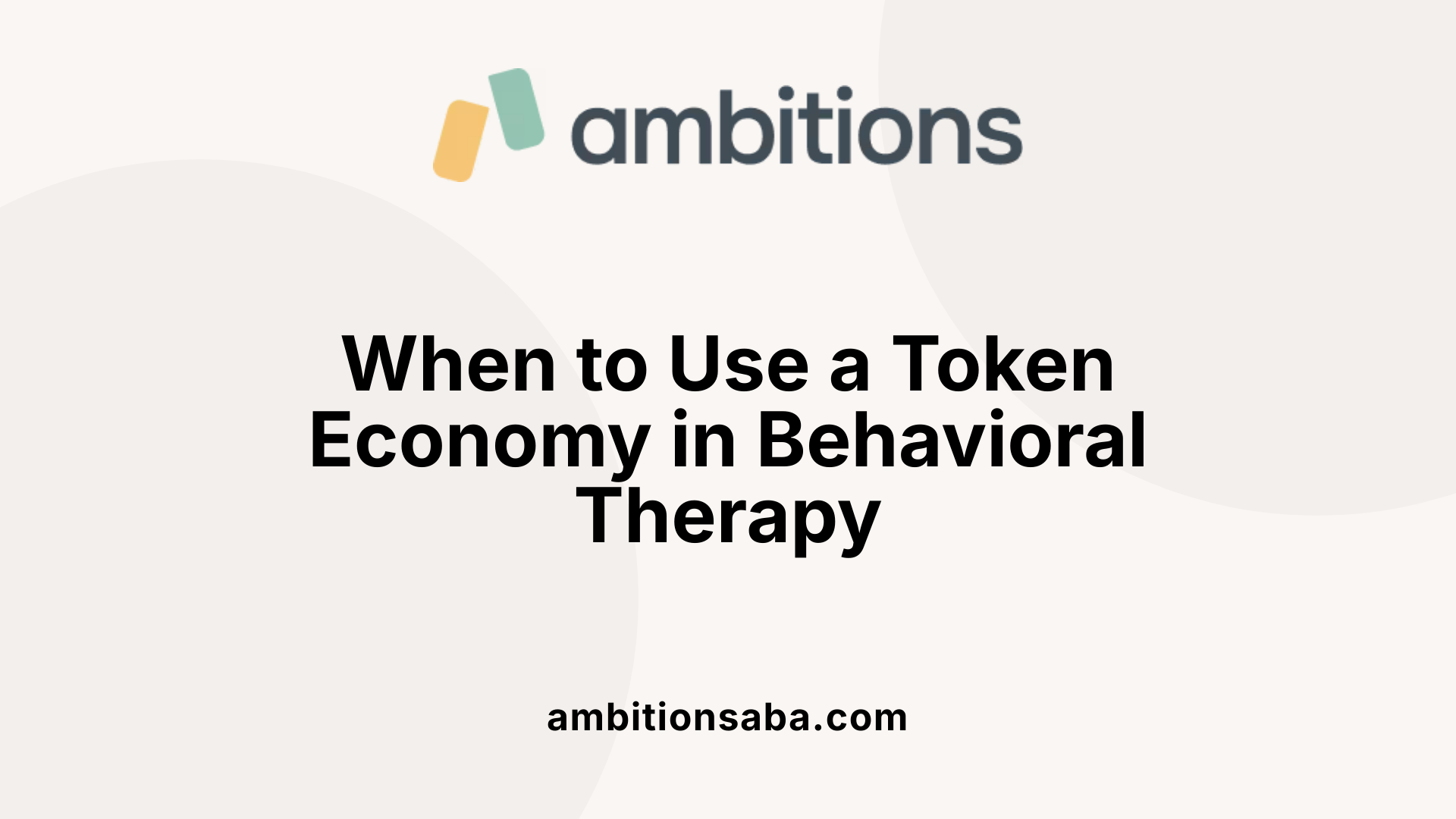
Ideal scenarios for use
A token economy is most effective in settings where structured reinforcement can enhance learning and behavior change. It is ideal when immediate feedback and visual progress indicators are vital for maintaining motivation. For example, classrooms, therapy sessions, or homes where consistent reinforcement supports skill development. The visual nature of tokens helps individuals understand their progress clearly, making it easier to stay engaged. This system works well in environments demanding routine and consistency, such as schools for children with autism.
Target behaviors and population suited
Token economies are especially suitable for populations with neurodiversities, including autism spectrum disorder (ASD), ADHD, and other developmental disabilities. They are effective in promoting behaviors like completing academic tasks, participating in social activities, following routines, and developing communication skills. The target behaviors are typically specified and measurable, allowing for clear reinforcement criteria. Children and adults alike benefit from the tangible and immediate reinforcement that tokens provide, helping them learn new skills or strengthen existing ones.
Advantages over other reinforcement methods
One major benefit of token economies is their ability to provide quick and consistent feedback, which boosts motivation. Unlike simple praise or verbal reinforcement, tokens act as conditioned reinforcers that can be collected and exchanged later for more meaningful rewards. This flexibility allows for reinforcement in various environments without depending on providing the actual backup reinforcer immediately. Furthermore, tokens help foster independence by enabling learners to self-monitor their progress and work towards specific goals.
When should a token economy be used as part of behavioral intervention?
A token economy is most appropriate when there is a need to reinforce or increase specific behaviors, especially if immediate reinforcement supports motivation over delay-based reinforcement options. It is particularly beneficial for individuals who thrive within structured, predictable environments. When target behaviors are clearly defined, and reinforcement schedules need to be systematically planned, a token economy provides a flexible and reliable method for encouraging positive change. It is also helpful when tracking progress with data collection to tailor interventions based on ongoing results. Overall, its use is ideal in situations where the reinforcement process is integral to sustained behavioral improvements.
Summary and Final Recommendations
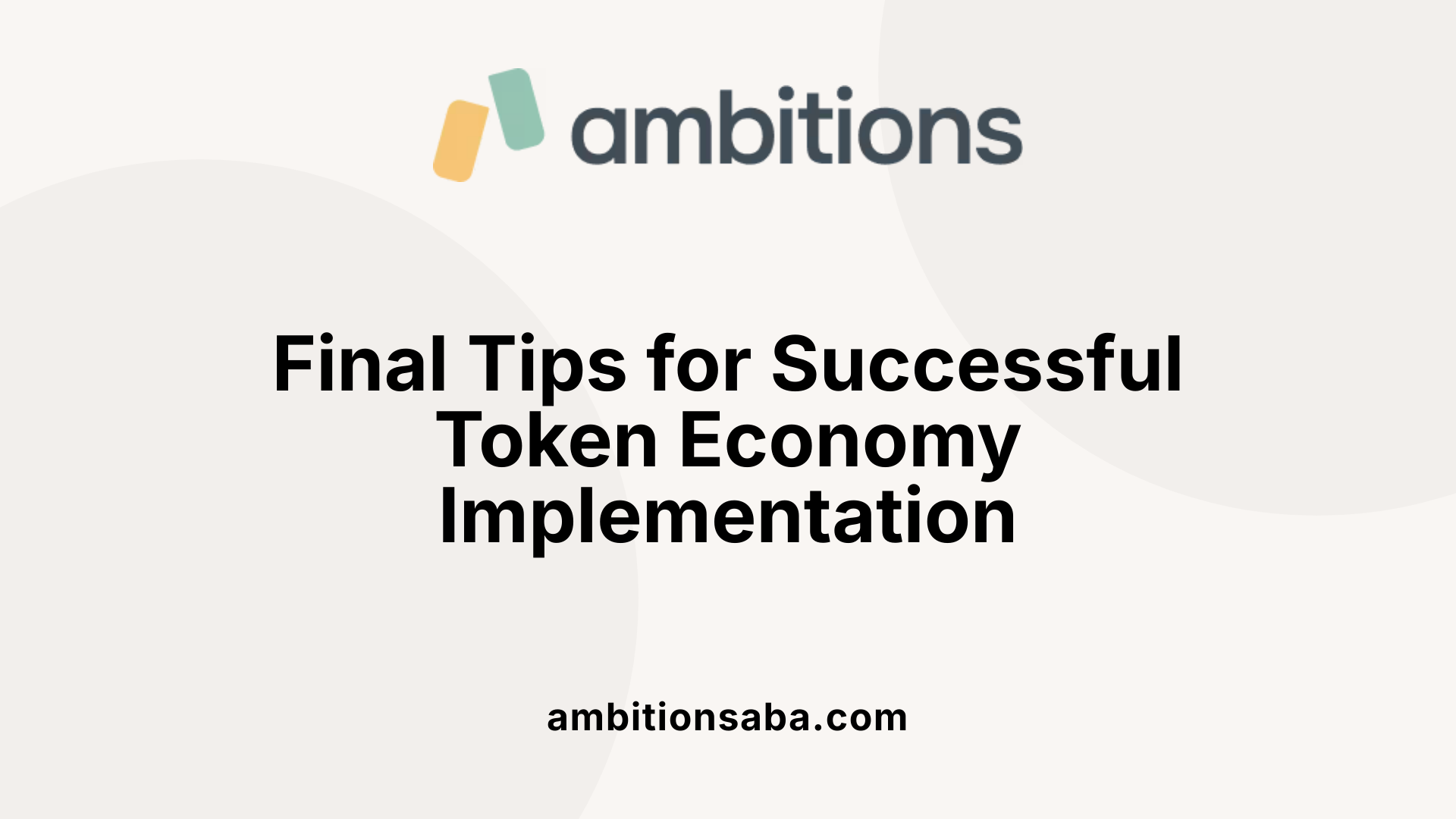 Token economies are a well-established reinforcement strategy used in ABA to promote desirable behaviors and reduce unwanted ones. They involve earning tokens for targeted actions, which are then exchanged for backup reinforcers like privileges or preferred items. This system provides clear, visual feedback, increasing motivation and helping individuals grasp the connection between their behaviors and rewards.
Token economies are a well-established reinforcement strategy used in ABA to promote desirable behaviors and reduce unwanted ones. They involve earning tokens for targeted actions, which are then exchanged for backup reinforcers like privileges or preferred items. This system provides clear, visual feedback, increasing motivation and helping individuals grasp the connection between their behaviors and rewards.
For effective implementation, it's essential to define specific target behaviors, select engaging tokens, and identify meaningful backup reinforcers. Starting with a few behaviors and gradually expanding helps maintain clarity. Consistent use, regular assessment, and data collection support sustained progress.
Challenges such as over-reliance on tokens, fairness concerns, and individual personalization require careful planning. Flexibility and ongoing adjustments are crucial to address these issues successfully. Engaging caregivers and educators in the process ensures consistency across environments and enhances outcomes.
Best practices include using tokens that are appealing to the individual, gradually fading reinforcement, and blending token systems with other behavior strategies. Keeping the system motivating and personalized makes it more effective over time.
Overall, when thoughtfully designed and implemented, token economies serve as powerful tools for skill development and behavior change across diverse settings, benefitting children with various neurodiversities and fostering independence.
Final Thoughts on Token Economies in ABA
The implementation of a well-structured token economy can significantly enhance the efficacy of behavioral interventions. By reinforcing positive behaviors systematically, setting clear expectations, and providing immediate feedback, token systems foster motivation and facilitate skill acquisition in diverse populations. Success depends on careful planning, consistent application, ongoing assessment, and customization to individual needs. When effectively integrated, token economies serve as powerful tools in promoting meaningful, lasting behavior change and independence.
References
- The Power of Token Economies - How to ABA
- Token Economy: Examples and Applications in ABA
- Common Practices used to Establish and Implement Token ...
- Token Economy ABA – Systems & Uses in Therapy - CentralReach
- How to Implement & Use Token Boards - How to ABA
- How Token Economy Systems Empower Growth in ABA Therapy
- Token Economy: Definition & Examples - ABA Therapist Jobs
- Token Economy ABA – Systems & Uses in Therapy - CentralReach
- Differential Reinforcement: A Complete Guide - Master ABA
- What is the Token System in ABA Therapy?

